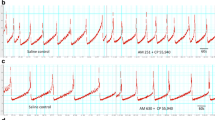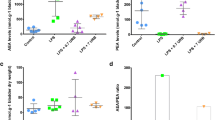Abstract
Introduction and hypothesis
Our aim was to compare expression and distribution of cannabinoid receptors CB1 and CB2, transient receptor potential vanilloid receptor 1 (TRPV1), and modulating enzymes in human and rat bladder. We also evaluated effects of cannabinoid agonists (ACEA, agonist of CB1; GP1A, agonist of CB2) on contractile responses of rat bladder strips.
Methods
Distribution and expression of CB1, CB2 and TRPV1 receptors and enzymes fatty acid amide hydrolase (FAAH) and N-acyl phosphatidylethanolamine-hydrolyzing phospholipase D (NAPE-PLD) was studied using immunohistochemistry and immunoblotting on human and Wistar rat bladders. The effects of cannabinoid agonists on contractile responses of isolated rat bladder strips to electrical-field stimulation (EFS) or carbachol-evoked responses were determined.
Results
Immunoreactivity for CB1 and TRPV1 receptors and FAAH and NAPE-PLD was present in the bladder of both species. CB1 proteins were of different sizes in rat (57 kDa) and human (40 kDa) bladder. CB2 (45 kDa in both species) immunolocalised to both urothelium and detrusor muscle in human bladder but only to detrusor muscle in rat. FAAH proteins were found at 55 kDa for both species. Rat NAPE-PLD protein (44 kDa) was similar in size to that in human bladder (45 kDa). TRPV1 proteins were found at 104 kDa in both species. ACEA (10−4 M) attenuated bladder contractions by 35 ± 5.4 % (p < 0.001); GP1a had no effect despite the EC50 values for the carbachol dose–response curves for both agonists being significantly shifted to the right.
Conclusions
The endocannabinoid system is functionally expressed in both species, with CB1 receptors showing both pre- and postsynaptic inhibitory effects on rat bladder contraction, whereas CB2 acts only postsynaptically.





Similar content being viewed by others
References
Haylen BT, de Ridder D, Freeman RM et al (2010) An International Urogynaecological Association (IUGA)/International Continence Society (ICS) joint report on the terminology for female pelvic floor dysfunction. Int Urogynecol J Pelvic Floor 21(1):5–26
Irwin DE, Milsom I, Hunskaar S, Reilly K, Kopp Z, Herschorn S et al (2006) Population-based survey of urinary incontinence, overactive bladder, and other lower urinary tract symptoms in five countries: results of the EPIC study. Eur Urol 50:1306–1314, discussion 1314–5
Freeman RM, Adekanmi O, Waterfield MR, Waterfield AE, Wright D, Zajicek J (2006) The effect of cannabis on urge incontinence in patients with multiple sclerosis: a multicentre, randomised placebo-controlled trial (CAMS-LUTS). Int Urogynecol J Pelvic Floor Dysfunct 17:636–641
Amar B (2006) Cannabinoids in medicine: a review of their therapeutic potential. J Ethnopharmacol 105:1–25
Gratzke C, Streng T, Park A, Christ G, Stief CG, Hedlund P et al (2009) Distribution and function of cannabinoid receptors 1 and 2 in the rat, monkey and human bladder. J Urol 181:1939–1948
Tyagi V, Philips BJ, Su R, Smaldone MC, Erickson VL, Chancellor MB et al (2009) Differential expression of functional cannabinoid receptors in human bladder detrusor and urothelium. J Urol 181:1932–1938
Strittmatter F, Gandaglia G, Benigni F, Bettiga A, Rigatti P, Montorsi F et al (2012) Expression of fatty acid amide hydrolase (FAAH) in human, mouse, and rat urinary bladder and effects of FAAH inhibition on bladder function in awake rats. Eur Urol 61:98–106
Egertová M, Simon GM, Cravatt BF, Elphick MR (2008) Localization of N-acyl phosphatidylethanolamine phospholipase D (NAPE-PLD) expression in mouse brain: a new perspective on N-acylethanolamines as neural signaling molecules. J Comp Neurol 506:604–615
Tsou K, Nogueron MI, Muthian S, Sañudo-Pena MC, Hillard CJ, Deutsch DG et al (1998) Fatty acid amide hydrolase is located preferentially in large neurons in the rat central nervous system as revealed by immunohistochemistry. Neurosci Lett 254:137–140
Geirsson G, Fall M, Sullivan L (1995) Clinical and urodynamic effects of intravesical capsaicin treatment in patients with chronic traumatic spinal detrusor hyperreflexia. J Urol 154:1825–1829
Birder LA, Kanai AJ, de Groat WC, Kiss S, Nealen ML, Burke NE et al (2001) Vanilloid receptor expression suggests a sensory role for urinary bladder epithelial cells. Proc Natl Acad Sci U S A 98:13396–13401
Hayn MH, Ballesteros I, de Miguel F, Coyle CH, Tyagi S, Yoshimura N et al (2008) Functional and immunohistochemical characterization of CB1 and CB2 receptors in rat bladder. Urology 72:1174–1178
Gratzke C, Streng T, Stief CG, Downs TR, Alroy I, Rosenbaum JS et al (2010) Effects of cannabinor, a novel selective cannabinoid 2 receptor agonist, on bladder function in normal rats. Eur Urol 57:1093–1100
Marquéz L, Suárez J, Iglesias M, Bermudez-Silva FJ, Rodríguez de Fonseca F, Andreu M (2009) Ulcerative colitis induces changes on the expression of the endocannabinoid system in the human colonic tissue. PLoS One 4:e6893
Ueda N, Puffenbarger RA, Yamamoto S, Deutsch DG (2000) The fatty acid amide hydrolase (FAAH). Chem Phys Lipids 108:107–121
Katayama K, Ueda N, Kurahashi Y, Suzuki H, Yamamoto S, Kato I (1997) Distribution of anandamide amidohydrolase in rat tissues with special reference to small intestine. Biochim Biophys Acta 1347:212–218
Desarnaud F, Cadas H, Piomelli D (1995) Anandamide amidohydrolase activity in rat brain microsomes. Identification and partial characterization. J Biol Chem 270:6030–6035
Giang DK, Cravatt BF (1997) Molecular characterization of human and mouse fatty acid amide hydrolases. Proc Natl Acad Sci 94:2238
Storr MA, Keenan CM, Emmerdinger D, Zhang H, Yüce B, Sibaev A et al (2008) Targeting endocannabinoid degradation protects against experimental colitis in mice: involvement of CB1 and CB2 receptors. J Mol Med 86:925–936
Dinis P, Charrua A, Avelino A, Cruz F (2004) Intravesical resiniferatoxin decreases spinal c-fos expression and increases bladder volume to reflex micturition in rats with chronic inflamed urinary bladders. BJU Int 94:153–157
Dinis P, Charrua A, Avelino A, Yaqoob M, Bevan S, Nagy I et al (2004) Anandamide-evoked activation of vanilloid receptor 1 contributes to the development of bladder hyperreflexia and nociceptive transmission to spinal dorsal horn neurons in cystitis. J Neurosci 24:11253–11263
Ishizuka O, Igawa Y, Mattiasson A, Andersson KE (1994) Capsaicin-induced bladder hyperactivity in normal conscious rats. J Urol 152:525–530
Lazzeri M, Vannucchi MG, Zardo C, Spinelli M, Beneforti P, Turini D et al (2004) Immunohistochemical evidence of vanilloid receptor 1 in normal human urinary bladder. Eur Urol 46:792–798
Brady CM, Apostolidis AN, Harper M, Yiangou Y, Beckett A, Jacques TS et al (2004) Parallel changes in bladder suburothelial vanilloid receptor TRPV1 and pan-neuronal marker PGP9.5 immunoreactivity in patients with neurogenic detrusor overactivity after intravesical resiniferatoxin treatment. BJU Int 93:770–776
Ost D, Roskams T, Van Der Aa F, De Ridder D (2002) Topography of the vanilloid receptor in the human bladder: more than just the nerve fibers. J Urol 168:293–297
Martin RS, Luong LA, Welsh NJ, Eglen RM, Martin GR, MacLennan SJ (2000) Effects of cannabinoid receptor agonists on neuronally-evoked contractions of urinary bladder tissues isolated from rat, mouse, pig, dog, monkey and human. Br J Pharmacol 129:1707–1715
Pertwee RG, Fernando SR (1996) Evidence for the presence of cannabinoid CB1 receptors in mouse urinary bladder. Br J Pharmacol 118:2053–2058
Walczak JS, Price TJ, Cervero F (2009) Cannabinoid CB1 receptors are expressed in the mouse urinary bladder and their activation modulates afferent bladder activity. Neuroscience 159:1154–1163
Birder LA (2010) Urothelial signaling. Auton Neurosci 153:33–40
Acknowledgments
We want to thank Dr. Tim Marczylo for his guidance with the experiments and for his suggestions towards the manuscript.
Funding
Wellbeing of Women
Conflicts of interest
None.
Author information
Authors and Affiliations
Corresponding author
Rights and permissions
About this article
Cite this article
Bakali, E., Elliott, R.A., Taylor, A.H. et al. Distribution and function of the endocannabinoid system in the rat and human bladder. Int Urogynecol J 24, 855–863 (2013). https://doi.org/10.1007/s00192-012-1954-1
Received:
Accepted:
Published:
Issue Date:
DOI: https://doi.org/10.1007/s00192-012-1954-1




